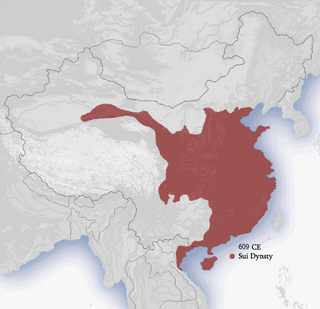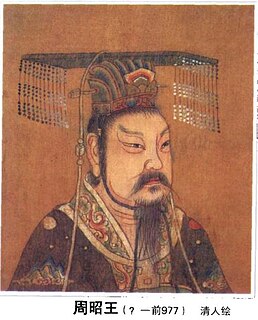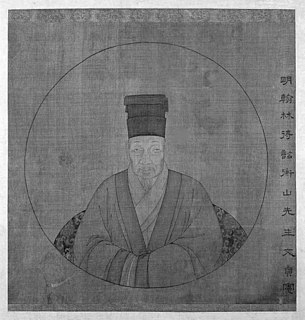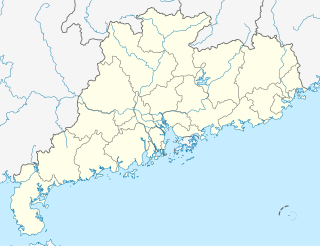
The Sui dynasty was a short-lived imperial dynasty of China of pivotal significance. The Sui unified the Northern and Southern dynasties and reinstalled the rule of ethnic Chinese in the entirety of China proper, along with sinicization of former nomadic ethnic minorities within its territory. It was succeeded by the Tang dynasty, which largely inherited its foundation.

The Zhou dynasty was a Chinese dynasty that followed the Shang dynasty and preceded the Qin dynasty. The Zhou dynasty lasted longer than any other dynasty in Chinese history. The military control of China by the royal house, surnamed Ji, lasted initially from 1046 until 771 BC for a period known as the Western Zhou and the political sphere of influence it created continued well into Eastern Zhou for another 500 years.

Yuan Shikai was a Chinese military and government official who rose to power during the late Qing dynasty, and tried to save the dynasty with a number of modernization projects including bureaucratic, fiscal, judicial, educational, and other reforms. He established the first modern army and a more efficient provincial government in North China in the last years of the Qing dynasty before the abdication of Xuantong Emperor, the last monarch of the Qing dynasty, in 1912. Through negotiation, he became the first official president of the Republic of China in 1912.

The Han Chinese people, Hanzu, Han people, are an East Asian ethnic group and nation native to China. They constitute the world's largest ethnic group, making up about 18% of the global population. The estimated 1.3 billion Han Chinese people are mostly concentrated in mainland China and in Taiwan. Han Chinese people also makes up three quarters of the total population of Singapore.

In Chinese sovereignty and peerage, the nobility of China, was an important feature of the traditional social and political organization of Imperial China.

King Zhao of Zhou, personal name Jī Xiá, was the fourth king of the Chinese Zhou dynasty. He ruled from 977/75 BC until his death twenty years later. Famous for his disastrous war against the Chu confederation, his death in battle ended the Western Zhou’s early expansion and marked the beginning of his dynasty’s decline.

Khanbaliq or Dadu was the capital of the Yuan dynasty, the main center of the Mongol Empire founded by Kublai Khan in what is now Beijing, also the capital of China today. It was located at the center of modern Beijing. The Secretariat directly administered the Central Region (腹裏) of the Yuan Empire and dictated policies for the other provinces. Kublai and his successors also claimed supremacy over the entire Mongol Empire, although in practice that had already fragmented into a number of khanates since the death of Möngke Khan.

The Northern Qi was one of the Northern dynasties of Chinese history and ruled northern China from 550 to 577. The dynasty was founded by Emperor Wenxuan, and it was ended following attacks from Northern Zhou.

Wen Zhengming, born Wen Bi, was a leading Ming dynasty painter, calligrapher, poet, and scholar. He was regarded as one of the Four Masters of Ming painting.

Dan, Duke Wen of Zhou, commonly known as the Duke of Zhou, was a member of the royal family of the Zhou dynasty who played a major role in consolidating the kingdom established by his elder brother King Wu. He was renowned for acting as a capable and loyal regent for his young nephew King Cheng, and for successfully suppressing the Rebellion of the Three Guards and establishing firm rule of the Zhou dynasty over eastern China. He is also a Chinese culture hero credited with writing the I Ching and the Book of Poetry, establishing the Rites of Zhou, and creating the yayue of Chinese classical music.

Son of Heaven, or Tian Zi, was the sacred imperial title of the Chinese emperor. It originated with the ancient Zhou Dynasty and was founded on the political and spiritual doctrine of the Mandate of Heaven. The secular imperial title of the Son of Heaven was "Emperor of China".

Runan County is a county under the administration of the prefecture-level city of Zhumadian, in the southeast of Henan province, China.

Ruan Yuan was a Chinese scholar official of the Qing Dynasty who was the most prominent Chinese scholar during the first half of the 19th century. He won the jinshi degree in the imperial examinations in 1789 and was subsequently appointed to the Hanlin Academy. He was known for his work Biographies of Astronomers and Mathematicians and for his editing the Shisan Jing Zhushu for the Qing emperor.

The Yuan dynasty, officially the Great Yuan, was the empire or ruling dynasty of China established by Kublai Khan, leader of the Mongolian Borjigin clan. It followed the Song dynasty and preceded the Ming dynasty. Although the Mongols had ruled territories including modern-day North China for decades, it was not until 1271 that Kublai Khan officially proclaimed the dynasty in the traditional Chinese style, and the conquest was not complete until 1279. His realm was, by this point, isolated from the other khanates and controlled most of modern-day China and its surrounding areas, including modern Mongolia. It was the first foreign dynasty to rule all of China and lasted until 1368, after which the rebuked Genghisid rulers retreated to their Mongolian homeland and continued to rule the Northern Yuan dynasty. Some of the Mongolian Emperors of the Yuan mastered the Chinese language, while others only used their native language and the 'Phags-pa script.
The distinction between Huá and Yí, also known as Sino–barbarian dichotomy, is an ancient Chinese concept that differentiated a culturally defined "China" from cultural or ethnic outsiders. Although Yí is often translated as "barbarian", other translations of this term in English include "foreigners", "ordinary others" "wild tribes", and "uncivilized tribes". The Hua–Yi distinction asserted Chinese superiority, but implied that outsiders could become Hua by adopting Chinese values and customs.
Zhou Xin was an official who lived during the late Eastern Han dynasty of China.

Yuan Xuefen was a noted performer in the Yue opera genre of Chinese opera. She has been called "arguably the most important actress in the recent history of Yueju [Shaoxing] opera". The only other artist to be ranked with her is Fu Quanxiang.
The Kingdom of Great or Greater Zhou was a state established in 1354 by Zhang Shicheng, one of the leaders of the Red Turban Rebellion. The Kingdom of Dazhou lasted for only 13 years and had only one King.
Jiang Yuan is an important figure in Chinese mythology and history. She is recorded as having lived during the ancient times of Chinese culture and history. Jiang Yuan was the mother of Houji, who is a culture hero and revered as the God of Millet.
The Dugu sisters were part-Xianbei, part-Han Chinese sisters of the Dugu clan who lived in the Western Wei (535–557), Northern Zhou (557–581) and Sui (581–618) dynasties. All were daughters of the Western Wei general Dugu Xin. The eldest sister became a Northern Zhou empress, the seventh sister became a Sui dynasty empress, and the fourth sister was posthumously honored as an empress during the Tang dynasty (618–907). The seventh sister Dugu Qieluo, in particular, was one of the most influential women in Chinese history, owing to her closeness to her husband Yang Jian throughout their 45-year monogamous marriage.

















